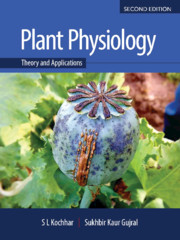Book contents
- Frontmatter
- Contents
- Foreword
- Preface to the Second Edition
- Preface to the First Edition
- Acknowledgements
- Some Common Abbreviations used in the Text
- Abbreviations for Units
- Unit I Water and Mineral Translocation in Plants
- Unit II Metabolism and Bioenergetics
- Unit III Growth and Development
- Unit IV Physiological Stress and Secondary Metabolites – Their Role in Metabolism
- Unit V Crop Physiology – An Innovative Approach
- Unit VI Breakthroughs in Plant Physiology
- Unit VII Some Experimental Exercises
- Glossary
- References
- Index
- Colour Plates
Chapter 3 - Transpiration
Published online by Cambridge University Press: 12 May 2020
- Frontmatter
- Contents
- Foreword
- Preface to the Second Edition
- Preface to the First Edition
- Acknowledgements
- Some Common Abbreviations used in the Text
- Abbreviations for Units
- Unit I Water and Mineral Translocation in Plants
- Unit II Metabolism and Bioenergetics
- Unit III Growth and Development
- Unit IV Physiological Stress and Secondary Metabolites – Their Role in Metabolism
- Unit V Crop Physiology – An Innovative Approach
- Unit VI Breakthroughs in Plant Physiology
- Unit VII Some Experimental Exercises
- Glossary
- References
- Index
- Colour Plates
Summary
In plant-water relations studies, the dominant processes are the uptake of huge quantities of water from the soil, its translocation through the plant and its subsequent loss from the aerial parts to the surrounding atmosphere in the form of water vapour through transpiration. Out of the total water absorbed by the plant during a growing season, about 99 per cent is lost to the atmosphere in the form of water vapour and only 1 per cent is retained by the plant. Out of this 1 per cent, roughly 0.9 per cent is retained as free water within the tissue and about 0.1 per cent enters into the plant's metabolism as a reactant in chemical reactions (e.g., photosynthesis). The process of water loss in the form of vapour from the leaf surfaces of the plant is called transpiration.
The loss of water is alarmingly high. The daily water loss of a large, well-watered tropical plant such as palm may be as high as 500 litres. A corn plant may lose 3–4 L/day and a medium-sized elm tree may lose more than a ton of water every day.
Transpiration is not a purely physical process like evaporation (loss of water from the surface other than the plant, such as soil) but is a vital phenomenon controlled by the cells. Most of the transpiration takes place from the leaves and is known as foliar transpiration that includes types like: stomatal, cuticular and lenticular.
Foliar Transpiration
Stomatal transpiration. Stomata are the primary portals of water loss during transpiration. It accounts for 90–95 per cent of water loss from leaves.
Cuticular transpiration. It accounts for 5–10 per cent of total water loss and is mainly dependent upon the thickness of the cuticle. Although this layer (consisting of a waxy substance cutin, and other hydrophobic polymers) generally can retard water loss, but, it is still permeable to small quantities of water vapour.
Lenticular transpiration. About 0.1 per cent of the total loss of water vapour occurs through lenticels present on fruits and woody stems. Plants also lose water in liquid form via ‘guttation’ and ‘bleeding’.
Guttation
Guttation is quite common in plants like garden nasturtium, colocasia, oat leaves, and such. (Figure 3.1). It is the oozing of drops of water from the uninjured tips or edges of the leaf where a major vein terminates.
- Type
- Chapter
- Information
- Plant PhysiologyTheory and Applications, pp. 75 - 99Publisher: Cambridge University PressPrint publication year: 2020



